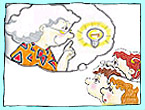Communicative functions: Interacting with others
| Adjusting our interaction with others |
Attributing point of view to someone
Sometimes we attribute a point of view to ourselves and sometimes to another person. This shows that what we say is only a point of view and other people can disagree if they wish. In these examples the point of view is attributed to other people:
 |
The grandchildren think Granny Gong is
the cleverest person in the world.
The grandchildren say that Granny Gong is the cleverest person in the world. |

|
The point of view can also be attributed to the speaker using expressions
such as I
think, I bet and I believe. For example:
I think she just wanted to try them. I don't think it's nice.
Here a receptionist makes a suggestion to a customer using the
expression I think:
Well I think you need to talk to the technical manager about that. Hold on.
For more information about responding to requests, see:
![]() Text types:
Particular Descriptions: Expressing feelings and opinions
Text types:
Particular Descriptions: Expressing feelings and opinions
![]() Grammar: Clause: Using clauses to
organise text: Focusing on feelings and attitudes
Grammar: Clause: Using clauses to
organise text: Focusing on feelings and attitudes
|
Tell me more ... Introduction |
|
||
To give us feedback about this section, click here or on the Comment button at the top of the screen.
If you have any questions about this section, visit the Language Corner.
If you have any questions or suggestions about how to teach this section, send a message to the Teaching Corner.